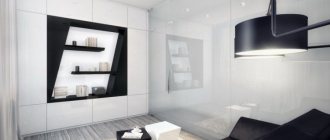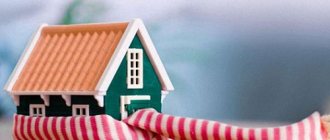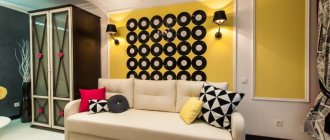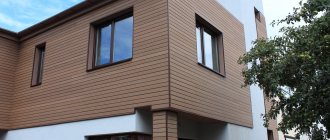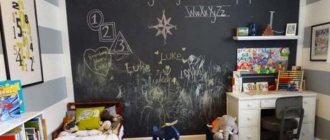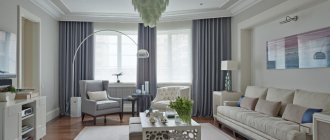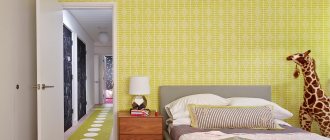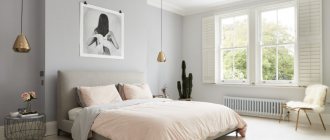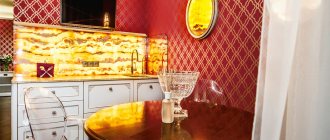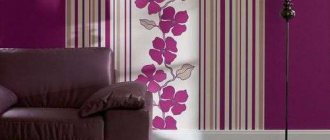Pros and cons of decorating walls with wallpaper
Wallpaper is the most common method of finishing walls in residential premises. Construction stores offer an incredible variety of colors, textures and materials, which allows you to choose the ideal option taking into account the characteristics of the apartment.
| pros | Minuses |
| Firstly, the advantages include a wide selection of colors and various effects. Today you can make a selection to suit any style, with imitation of various materials and absolutely any image, from a nondescript ornament to a complex artistic 3D image. | Despite all the positive qualities, wallpaper for walls still cannot boast of such durability as, for example, ceramic tiles. Only a few species can withstand animal claws and other household damage. |
| Variety in price can also be considered an advantage. The cost of wall coverings depends on the characteristics and type of material and some of them are quite expensive, but the price range starts with very budget models. | Walls of shower areas and open balconies cannot be finished. |
| Not all types have a long lifespan, although some reach 30 years. | |
| The variety of types allows finishing in rooms with different conditions, for example, high humidity, abundant lighting or possible frequent mechanical damage. | Some types are almost impossible to wash from various types of contaminants. |
Selection of materials for interior decoration
When developing a project for a future interior, you should take into account the technical features and dimensions of the apartment or house. The decoration of the room, the selection of colors and the characteristics of gluing are closely related to the type of wallpaper purchased for decoration.
Search for materials by color and print
The walls of the room are the main background for furniture and decorative items. Correctly selected wallpaper will help make the interior harmonious and highlight the features of the set or dining table.
Spacious and bright rooms with plenty of natural light are best shaded with cool colors, such as light gray. Dark and warm shades visually reduce space, so you should avoid using them in a small kitchen or compact living room.
A contrasting vertical strip allows you to elongate the room, hiding the actual height of the ceilings.
Horizontal lines visually expand the walls.
Wallpaper with fine patterns in warm colors is suitable for medium-sized rooms. A large print on the wall is dangerous because it creates the illusion of a small space. Therefore, large-flowered wallpaper patterns are completely unsuitable for small rooms.
Selection of finishes according to the texture of materials
Thin glossy wallpaper without any texture looks perfect on perfectly smooth walls. The smooth canvas fits equally well into rooms of both large and small sizes:
- compact rooms with wallpaper without texture appear larger;
- spacious apartments, the walls of which are decorated with similar material, optically look even more majestic.
Textured wallpaper with a voluminous relief pattern is not suitable for use in limited spaces. With them, small rooms will seem even smaller, and the risk of a peculiar “pressing walls” effect increases. But this type of finishing material is simply irreplaceable for uneven surfaces.
Fans of interesting textures can turn their attention to liquid, textile or fiberglass wallpapers, which allow them to achieve interesting design results. Also, finished walls with an unusual texture can be enhanced in an original way with the help of lighting.
Choice based on interior style
When looking for the best option among thousands of types of finishing materials, you should not forget about the style of the interior in which the renovation is being carried out. Thanks to different prints, choosing wallpaper that matches a specific trend will not be difficult even for a person far from the basics of design. But there are still some nuances that you should pay attention to when purchasing:
- To highlight Provencal motifs in the interior, take a closer look at smooth wallpaper in delicate and soft shades, such as blue, pale pink and light lilac. A small floral print depicting miniature roses also signals that it belongs to French country;
- Golden monograms and rich ornaments belong to the more pompous and majestic Empire, Rococo and Baroque styles;
- Loft welcomes imitation of natural materials. Textured stonework or a noble brown wooden frame depicted on the wallpaper will refresh and complement the interior in a loft direction.
Combination in the interior
The combination of wallpaper of different colors and textures opens up the designer’s range of possibilities and serves as a real tool for correcting a room.
If you like large ornaments, but the small dimensions of the room do not allow you to turn your design dream into reality, you can always use the “active” wall technique. Choose one area that you want to draw attention to and cover it with wallpaper with an interesting pattern. For the remaining walls, choose plain wallpaper to match. For example, in this way you can decorate the wall behind the head of the bed in the bedroom.
Wallpaper plinth is another option for the classic combination of two types of materials. In rooms with low ceilings, it is appropriate to make a small dark-colored plinth, combined with a light “top”. The lower part of the wall can also be finished with wallpaper with a black and gray pattern, which will also visually add the missing centimeters to the room.
The horizontal joint of dissimilar finishing materials must be covered with a border.
Types of wallpaper
Each type of wallpaper for walls has its own distinctive features, different characteristics, composition and external effects. If there are some doubts about the choice of material, then there is a detailed overview of all types, thanks to which you can choose the most optimal option, taking into account all the nuances of the room.
- Paper. Budget type of wall decoration with a large selection of colors and patterns. The material has poor strength and durability, fades in the sun, absorbs odors and is practically not suitable for any cleaning. Paper ones are suitable for finishing enclosed spaces with the least possible contact, for example a bedroom or the upper part of a nursery, a corridor with a horizontal finishing method.
- Non-woven. This species can be divided into two subspecies. Fully non-woven wallpaper with a non-woven base. The first type is most often used for painting. It has a varied relief texture that can match almost any stylistic direction. The second type has a top layer of vinyl, they do not need to be painted, the surface can have a different pattern and color.
- Vinyl. This popular type of wallpaper for walls is durable and strong. Vinyl coating is made in different variations with different external effects: silk-screen printing, foamed, hard vinyl. The surface is suitable for wet cleaning and finishing of any premises.
- Liquid. This type is different from all the others. They are purchased in powder form and diluted in water before use. Liquid wallpaper is applied to walls like plaster, which avoids joints on the surface. The material breathes and goes well with other methods of wall decoration.
- Glass wallpaper. The most durable type of all listed. The composition uses glass, which under the influence of high temperature is drawn into fibers, and then turns into canvas. Fiberglass wallpaper for walls is most often used for painting. The coating has a breathable surface, is suitable for repeated painting, and is not afraid of mechanical damage and high humidity.
- Textile. The material has a base and an upper textile covering, which can be made of different materials. The wallpaper has excellent appearance and natural composition, protects against noise and does not react to sunlight. However, dust can settle on the surface, with the exception of linen coverings and the material absorbs odors.
- Linkrusta. Wall coverings of this type are not so widely popular, but their quality characteristics are superior to other materials. The composition of linkrust is absolutely natural, based on wood. The coating is not afraid of mechanical damage and high temperature, has a long service life and an elegant appearance.
- Natural. This type includes bamboo and cork coverings, which are made from natural raw materials. The materials, first of all, are environmentally friendly, resistant to changes in humidity and temperature, and are suitable for finishing balconies and verandas. Natural wallpaper for walls does not differ in the variety of colors and textures.
- Photo wallpaper. Wallpaper with photo printing will make the interior unusual, stylish and individual, and will also successfully cope with the issue of space zoning. The drawing can be close to the real image (cities, flowers, animals), with a 3D effect, stereoscopic or expand the space.
The photo shows a modern bedroom interior, the walls are decorated with wallpaper with a three-dimensional pattern.
Time is like the best controller
Options for decorating a room with wallpaper can present the most incredible surprises that make you remember that there is no arguing about tastes after all.
And it’s all about the huge range of wallpaper types that the market offers.
Range
Among the types of wallpaper that are at your disposal:
- paper - these “old ladies” have already served their purpose, although they can still be used where it is required quickly, firmly, without much beauty and if they are ready to quickly replace;
- non-woven - if we talk about statistics, then these “reinforced” paper ones are now the most popular, successfully combining excellent design capabilities, durability and environmental friendliness;
- vinyl - these add a third, top, reinforcing layer to non-woven wallpaper, which makes this type of wallpaper even more resistant to external influences, provides better conditions for maintenance, but reduces environmental friendliness, so much so that vinyl is not recommended in children's rooms;
- glass wallpaper - the use of weaving capabilities using silicone threads led to the creation of this type of wallpaper, which has nothing to do with the much-maligned fiberglass; the result is a very durable and stable relief material;
Wallpapers are also provocateurs - there is a whole family of provocative wallpapers that should be used with great care
- luminous, fluorescent - long gone are the days when dangerous phosphorus was used to ensure the glow effect; modern luminous wallpaper uses a variety of new substances that can accumulate light energy and then release it, the most famous of them is phosphor; if you use this wallpaper wisely, it will add a special charm to the design of the room;
- photo wallpaper is a very popular type of wallpaper that is tempting with its ready-made simplicity, allowing you to radically and incredibly change the design of a room in just half an hour; by and large, there are no restrictions, everything that you can display on your computer screen can be presented on a much larger scale on your wall;
If you don't have grand design ideas, use minimalist ideas that will never let you down
- cork and bamboo - these are distinguished by their unusualness and extreme environmental friendliness, perhaps you will not cover the entire wall with this wallpaper, but highlighting a certain area is always stylish and appropriate;
- liquid - we usually classify this as wallpaper, because it contains more than two-thirds of cellulose, although in fact it is a dry mixture; environmental friendliness and ease of combining different colors on one plane are two trump cards of liquid wallpaper.
The combination of wallpaper, painting and existing “printing” techniques and tools brings even more possibilities to decoration
Accessories
Such a large assortment of wallpaper forced the construction industry to take care of additional materials and tools for working with wallpaper:
- This is, first of all, glue for fixing wallpaper on the surface; For almost every type of wallpaper, special adhesives have been developed, which are recommended to be used; all of them are mostly a dry mixture, but special types of adhesives intended for processing joints are supplied in the usual packaging, in tubes, in the form of a ready-made adhesive mass;
- then, a whole family of rollers, both for applying glue and for smoothing wallpaper, working at joints and corners:
- A – the main roller used on wallpaper to smooth the surface (width can be 15-30 cm);
- B – a very convenient roller in the form of a small barrel for processing joints;
Four types of rollers used (see description in text)
- C – work on corners requires special attention; there is also a roller for this work;
- D – special rollers are also used for applying glue.
Additional features
A large assortment of wallpapers is also supported by some additional features within some types:
- firstly, there are non-woven wallpapers that can be painted, which makes it possible to quickly change the original design of the room using specially selected paint; there is a limit on the number of colors of non-woven wallpaper: in the best case, no more than 10, but the use of special stencil rollers allows you to create almost any pattern, even a random one, which always looks very good;
- secondly, there are non-woven wallpapers, the pattern on which appears if they are glued to a pre-prepared paint layer. If you don’t quite understand the technology for obtaining the pattern you like on the wallpaper, most likely it’s non-woven wallpaper with the paint showing through;
Decorating a bedroom with wallpaper is often accompanied by choosing a photo to cover the entire wall - the main thing here is to show taste and not overdo it with the plot
- thirdly, most glass wallpaper is designed specifically for painting, which can be done at least 15, and even 25 times; this significantly increases the design capabilities of the material;
- fourthly, liquid wallpaper is very simple in a combination of different textures and patterns; It’s enough to add large sawdust to the mixture, and here’s a completely different surface; In addition, this wallpaper can be very easily removed from the wall - it can be removed with a simple wet rag;
- fifthly, textured wallpaper (although this can also be attributed to ordinary smooth wallpaper) allows you to smooth out some unevenness of the working surface, freeing you from the need for too thorough preparation.
The main thing is to correctly align the vertical with your own hands and stick the first roll along it, as the instructions say, further actions are already largely done automatically
Design conditions
Wallpaper provides great opportunities for creativity, which, however, has its own laws:
- the most important - all the elements that form the interior of the room must be strictly coordinated with each other, both in color perception and in shape;
- hence the conclusion - make the choice of wallpaper last, when you have already decided on the design of the furniture and the finishing of the floors and ceilings; the fact is that choosing wallpaper to match the rest of the decor is much easier than choosing furniture to match the wallpaper;
- another conclusion - be sure to pre-model the entire future appearance of the room and do not be lazy to experiment and look for the best solution among the good ones;
- Feel free to use different styles; more often than not, this allows you to solve the problem of lack of necessary materials and create something unusual practically from scraps.
The photo shows a typical type of glass wallpaper, its characteristic feature is a regular and relief pattern for painting
Color spectrum
Table of the most popular colors
Beige
Turquoise
Blue
Gold
Reds
Lilac
Purple
Burgundy
Yellow
Greens
Brown
Orange
Peach
Light green
Gray
Blue
Black
White
Pink
Mother of pearl
The iridescent surface will look interesting in the light, and if a relief pattern is applied, it will create a play of light and the illusion of volume. Mother-of-pearl wallpaper for walls can be in the form of an imitation of Venetian plaster or silk-screen printing. Both options suit different styles and look impressive.
The photo shows mother-of-pearl walls in blue tones.
Mints
A refreshing shade is suitable for decorating rooms with south-facing windows. The color is like a fusion of light turquoise and blue shades, it will look good in modern, Scandinavian, Provence, shabby chic styles.
Wall alignment
Apartment with perfect surfaces
Preparing the base
Drywall is loved because such finishing options do not require preparing the base (if the wall is problematic, this is a big plus). Which may be one of the reasons for choosing drywall as opposed to plaster for surface leveling purposes. In general, all primers for bases are divided into two types:
- The first family of primers is called penetrating. They are usually transparent. This is inconvenient, but in most cases it is by color that one can distinguish one type of soil from another. This refers to the case where there are no labels on the container. The purpose of the penetrating primer is to strengthen the base. A polymer matrix is created inside the wall, firmly holding the material in a bound state. Penetrating primers are used on crumbling or porous substrates.
- Unlike the previous family, surface primers create a slight roughness on the base. This allows all other layers to grip the uneven surfaces. You should know that surface primers have different purposes. Some building mixtures are designed to prepare a coating for applying paint, others for putty. And there is no need to confuse them with each other. There are also primers for wallpaper. But many craftsmen use glue for the same purposes, diluted 3-4 times thinner than the desired consistency.
Surface priming
Both types of primers listed above are applied one after another sequentially. At first, the base is strengthened, then a layer with a slight roughness is created on its surface. In this case, it would be correct to choose the right type of primer in the store. In this case, it is necessary to evaluate the properties of building mixtures. First of all, this concerns vapor permeability. If this parameter is high, then the use of primers does not have any effect on the structure. That is why in most cases it is recommended to use such materials. But for interior work, in many cases it is necessary to reduce the vapor permeability. Some polymer primers are very suitable for this. You can learn more about their vapor permeability from the dealer; in order to know what to compare with, it is recommended to look at SNiP II-3-79, which lists the characteristics for various building materials.
All this greatly influences such concepts as dew point and proper operation of load-bearing structures. In addition, before finishing residential premises, you need to ensure that building mixtures are potentially safe. This applies to both the materials used and those already available. What does it mean? Let's say the outside of the house is insulated with glass wool. The walls are made of brick. It has fairly good vapor permeability. Over time, phenols and formaldehydes begin to be released from glass wool. They seep through the wall and enter the room, harming the health of the inhabitants. If you now prime it with a material with low vapor permeability, then this defect can be corrected. The glass wool will serve for some time without harm to the inhabitants.
Yes, to this you can notice that the house will stop breathing, and we will say in response that it is better to hold your breath a little rather than absorb various toxins from the environment. Thus, the simple process of wallpapering can significantly improve the performance of a building. For example, the vapor barrier layer we specified from inside the room reduces the likelihood of dew falling. At the same time, due to this, air exchange with the environment is actually reduced. But this parameter is quite difficult to estimate, and the dew point is calculated using any construction calculator, so our readers can check the conclusions made with their own hands.
Wallpaper with raised dots
Aligning the wall with wallpaper
As we mentioned above, finishing the walls for wallpaper ends with the leveling stage. This can be done using plaster or drywall. The option, oddly enough, is often chosen not for reasons of cost, but for the purposes pursued by the customer. Let's say that when finishing the ceiling, many people want to make sound insulation. In this case, the use of plaster is simply not advisable. It is much easier to create a sheathing, run electrical wiring inside, cover it all with plasterboard and pour ecowool inside through the holes.
At the same time, it is much more appropriate to finish the walls with plaster. This saves space. Interior walls absolutely need to be finished with plaster. In this case, noise insulation is rarely required. As for the walls facing the neighbors, many here would not refuse a piece of silence. If the entrance is quiet, it won’t hurt to remove the vapor permeability of the walls; in any case, it won’t make things worse. According to the latest data, rooms separated by a partition continue to actively exchange air. That is, the joke about the farting neighbor is to some extent a reality.
Leveling walls with plasterboard
To carry out a vapor barrier, the use of plasterboard for cladding is not necessary. It is enough to find primers and plasters with high resistance on sale. Usually these are any cement-lime mixtures, but impact properties are achieved by using polymer compounds. Here it is important to find a middle ground between health hazards and the effectiveness of the building material. Because most of the modern products of the chemical industry are not completely harmless to human health. If it is not possible to achieve the required parameters with primer, plaster and paint, then special membranes will have to be used. It will be difficult to do without drywall here.
There is some good news. It is quite acceptable to use polyethylene for interior partitions. Its vapor barrier properties are almost an order of magnitude higher than any other coatings. Here you need to properly consider the consequences. If water can get inside the load-bearing structures, then it is imperative to leave a way out in the form of vapor-permeable walls. To tell you a secret, hardly any of the neighbors will think of insulating them with polyethylene, so nothing terrible will probably happen. Wall decoration with liquid wallpaper can also be considered as a similar measure. Therefore, the material has the advantage that, if necessary, it can be washed off. At the same time, the dried layer has good vapor barrier properties.
Plasterboard leveling
Many people are probably concerned about what type of plaster should be used to line the walls for wallpaper. Judge for yourself. Gypsum plasters are afraid of moisture. On one side, you can level it with a mixture, because wallpaper also doesn’t get along well with water. We are not taking into account the case where the owner carefully washed the corresponding type of cladding with a cloth. This refers to an emergency situation, such as a flood. After this, you can scrape off the wallpaper along with the plaster literally with your hands.
To create a high-quality coating, it is recommended to use moisture-resistant plasters. Mostly these are mixtures of cement or limestone. The latter also kill microbes. Final leveling is carried out with putty. If the plaster is applied along the exposed beacons, then in this case there is no longer any need to maintain any accuracy. A plaster wall is usually quite smooth. Therefore, the putty is simply spread with a spatula.
And a few words about drywall. It is used only in dry rooms. Placed on a metal or wood frame. The first option is considered more professional. But there are a great many assembly options. We recommend that you read the relevant reviews on our website. The most important place when installing drywall is cutting the seams. A special tool is used for this.
The walls are covered with wallpaper
How to choose the right wallpaper?
Simple rules and some tricks will help you choose the best option for finishing.
- For a small room, you should choose a light palette for decoration.
- Wallpaper with stripes, depending on the direction, will visually make the room taller or wider.
- To visually bring the wall closer or reduce the space, wallpaper in bright colors and with large patterns is suitable.
- For rooms with high traffic or a high probability of mechanical contacts, it is better to choose anti-vandal coatings.
- Washable coatings with high moisture resistance are suitable for the kitchen, bath and toilet: vinyl, fiberglass, liquid, self-adhesive.
- For a child’s room, you should choose the safest possible material; eco-friendly wallpaper, such as cork, glass wallpaper, or bamboo, is suitable.
- For a country house or cottage, you need to choose a material that is not afraid of temperature changes and humidity.
- The color palette should reflect the character of the owner; to decorate a women’s room, you can choose delicate pastel and light shades. Brutal cold shades are suitable for a masculine interior.
- For those who are interested in Feng Shui, it is worth paying attention to colors, each shade has its own meaning, for example, white clears the mind, blue inspires, and green has a calming effect.
Wallpapering
The technology for applying wallpaper depends on the type of cladding chosen. Vinyl wallpaper on a non-woven basis, which is so popular today, does not stand out as anything special in the general series. The surface is usually primed before applying them. In this case, you can use liquid glue. That is, the ratio of water in it is higher. Then you need to wait until the primer is completely dry.
Before pasting, it is advisable to draw the wall with vertical lines. Now is the time to read the label. Usually it indicates whether the wallpaper is glued end-to-end or overlapped. How to orient them correctly, how much to retreat between adjacent rolls, and whether it is necessary to do this at all. Finally, some types of wallpaper can only be installed using instructions. Some varieties even come with a DVD with educational materials. The decoration of walls with other types of wallpaper varies so much:
- bamboo;
- stone;
- cork;
- liquid.
In the above list, a deviation in one direction or another can lead to unpredictable consequences. In some cases, this simply spoils the appearance. For example, there is no way to guess that after gluing stone wallpaper, it needs to be primed along the joints in order to erase traces of the seams. Well, we have already discussed the design of wall coverings with wallpaper. All the best!
Rules for decorating walls with wallpaper
When working with wallpaper, you must follow simple, but still rules.
- It is necessary to apply wallpaper only to the prepared surface; the walls must be cleaned, leveled and primed,
- The glue must be selected in accordance with the characteristics of the material; for some types, glue for heavy types of coatings will be needed.
- When choosing wallpaper for walls, you need to take into account the features of caring for them. To do this, a marking is placed on the back of the roll or package indicating the degree of interaction with moisture.
- Structural wallpaper for walls designed for this purpose, such as fiberglass or non-woven, is suitable for painting.
- It is important to pay attention to the symbols on the packaging; they greatly simplify the choice.
- When combining wallpaper for walls, you need to select canvases of equal thickness and preferably from the same manufacturer.
- Regular maintenance can extend the life of the coating and maintain its appearance.
Differences in gluing different types of wallpaper
It is better to find out how to properly glue non-woven wallpaper in the instructions supplied with it. Typically, glue is applied only to the wall (immediately over a large area), and dry canvases are glued to it.
To apply paper wallpaper, apply glue only to it (with a wide brush from the center to the edges, paying special attention to each edge). Let it soak for 2-3 minutes - and feel free to glue it to the wall!
So, in our instructions, all that remains is to tell you how to properly glue vinyl wallpaper. Perhaps working with them has the most subtleties. Due to their material (elastic polymer - vinyl), they are able to stretch slightly. You should not apply too much glue to vinyl wallpaper and you should not stretch it when joining. Otherwise, after drying, they will “shrink”, separate, and the joint will be noticeable.
When pasting vinyl wallpaper, many people prefer to go through the joints of the canvases not with wallpaper, but with a special glue for the joints, which will protect the coating from the “shrinking” effect in the future.
It is most convenient to glue wallpaper together: one person holds the roll near the ceiling, and the second matches the joint.
Therefore, enlist the support of a friend, relative or your “other half” - and forward to interior experiments!
Wallpaper colors
Color solutions completely depend on the preferences of buyers, and a competent combination of tones will make the interior refined and unique. Often choosing colors can be difficult.
The way out of this situation is simple: you need to find related tones. For example, combine burgundy with hot pink, beige with vanilla or brown undertones.
Do-it-yourself decorative wall decoration with liquid wallpaper
The whole process is quite simple and does not require any unique skills.
A small amount of the finished mixture is placed on a trowel (grater) and, with light hand pressure, it is leveled over the surface. The tool should be held at a slight angle relative to the wall (10-15 degrees). The optimal recommended layer thickness is 1-2 mm. As the layer thickness increases, the material consumption increases. When reduced, “bald spots” may appear. It is not recommended to work in circular movements and level the same area for a long time.
Work should start from the most difficult areas - corners, windows, doors, switches, sockets. Do not allow the edges to dry out. In this case, a noticeable joint seam may appear. If the edge has dried out, you should soak it with water, smooth it with a trowel and continue working. To obtain a uniform color over the entire surface, it is important to maintain a uniform layer thickness.
After the liquid wallpaper solution has been applied to the entire surface, you need to go over it with smoothing movements with a trowel (grater) moistened with water.
In an hour of manual work, you can cover up to 8 m2 of surface. If you need to cover a very large area with liquid wallpaper, then it is most rational to use a special spray gun. The finished mass is immersed in a tank and the mixture is sprayed under pressure (3-5 atmospheres). With the help of such equipment it is possible to apply liquid wallpaper to an area of about 100 m2 in 5 hours.
Decorative liquid wallpaper can also be used to create both simple and voluminous designs on the wall.
Decorative panels on the wall instead of wallpaper
Decorative panels are one of the most popular modern finishing materials used as wall coverings. When laying decorative panels, no preliminary preparation of the walls is required.
Such decorative wall coverings are available in a wide range and can be made according to:
- Wood of various species;
- Ceramic tiles;
- Stone;
- Metal;
- Sand;
- Marble.
This is simply incredible beauty, with which it is quite possible to decorate walls in absolutely any room. This will allow you to create a rather unusual and most non-standard room design. The most popular and in demand type of panels are those made from wood-based panel materials. Such materials have high strength and moisture resistance. They are able to withstand the maximum possible loads and temperature changes.
Even more information about wall finishing options can be read in the following material: https://homeli.ru/komnaty/prikhozhaya/foto-otdelka-prikhozhej-panelyami-mdf
Subtleties and tricks when decorating walls with liquid wallpaper with your own hands
If you don’t have the skills to apply liquid wallpaper, then you should start the work from a place that will later be covered with furniture.
If the distribution of the finished mass over the area is unsuccessful, it is worth scraping off this mass, mixing it with the main mass and distributing it over the surface again.
If during the work process defects, irregularities, cracks, or dried edges appear on the surface, you can moisten this area with water using a spray bottle and level it with a tool.
A damaged area of wallpaper, for example, wiped by furniture, can be cut out, soaked in water and distributed again on the wall.
The remaining finished mixture can be saved after finishing work. To do this, you need to level it to a thickness of 10 mm, dry it and put it in a sealed bag. To reuse, just soak the prepared dry mixture with water.
What is decorative liquid wallpaper for walls?
This is a material used for interior decoration. Consisting of small particles of natural fibers processed in an adhesive composition with the addition of decorative elements.
Liquid wallpaper for walls is sold in the form of a dry bulk mixture, packaged in plastic bags, or less often in the form of a ready-made mixture diluted with water.
Liquid coating can be used to decorate walls and ceilings. Based on the method of application, they are often compared to decorative plaster, but, in fact, liquid wallpaper has nothing in common with it.
Perfect for both residential and office space. High-quality liquid wallpaper has increased resistance to fire, repels dust and is made from environmentally friendly materials, such as:
Fibers of natural or artificial silk and cotton;
Cellulose fibers;
Polyester;
Seaweed;
Dyes;
Decorative inclusions (mineral chips, mica particles, marble chips, sparkles, mother-of-pearl);
Alternative solutions
Above I have not described all the options for finishing. The list included only the most sought-after and popular ones. But my article would be incomplete without mentioning, albeit not so common, but no less effective ways of decorating walls.
Tiled disgrace
Tiles are now used not only in bathrooms and kitchens!
Until recently, I (I think, like many of you) considered tiles to be a material that was reserved for the bathroom and kitchen. Recent fashion trends indicate the opposite. If handled properly, tiles can be successfully used in the interior of a hallway, or, who knows, the living room.
Here is an example of the successful use of mosaic tiles in the interior
Why is it worth at least thinking about using tiles outside the kitchen? There are several reasons:
- The material is very durable and easy to clean.
- The tiles are characterized by fairly good sound insulation, which will come in handy with thin Khrushchev walls.
- This material is fireproof, so from the point of view of fire safety it has practically no equal.
- The range of colors allows you to decorate any decor.
Tiles can decorate the interior of not only baths and kitchens
Everything is clear about the advantages, but are there any disadvantages to this coating? But, alas, there are shortcomings. Among them:
- complete inability to lay tiles efficiently without the help of professionals;
- ceramics can hardly be called one of the most budget options, but it’s hard to deny that high-quality tiles look luxurious and fully deserve their considerable price.
Can you believe that such an interior was created using ordinary tiles?
By the way, here is some more useful information that may come in handy during the repair process. Ceramic tiles are divided into 5 types depending on the scope of their application:
- Tiles exclusively for wall decoration.
- Material for flooring (preventing walking on it in street shoes).
These floor tiles look solid, don't you agree?
- For office and residential premises where there are not particularly large crowds of people.
- Tiles for use in high traffic areas.
- A universal material suitable for installation anywhere.
Tiles can be used equally well for both floor covering and wall decoration.
Why not a stone?
Decorative stone, despite all its effectiveness and beauty, is not included in the TOP 3 most popular materials. The point is its high cost, which is not accessible to everyone. But apart from this, decorative stone (or brick) has many advantages that I have no right not to mention.
Decorative stone can bring its own atmosphere to the interior
- This material is very durable, its service life is approximately 50 years.
- Without having any special skills, but having studied good instructions, even a simple layman can handle the installation of the coating.
- All kinds of additives that are now included in decorative stone make it possible to create coatings with all sorts of textures.
- This material is completely environmentally friendly.
- Stone brings originality and unusual notes to the interior.
Durable and effective material for decorating a fireplace
Of course, artificial brick or stone cannot avoid comparison with its natural counterpart. Against this background, it has only three drawbacks:
- Its shelf life is still less than its natural counterparts.
- It is inferior to them in strength.
- Decorative stone cannot be used in large quantities, as it makes the interior heavier.
A lot of stone in the interior is bad, it is better to use it in doses
What is linkrust?
I admit, I learned about such a magical material with a strange name relatively recently. For those who are as unenlightened as I am, I will explain: linkrust is a material during the manufacturing process of which a thin layer of gel based on linseed oil or alkyd resin with a filler (cork or wood flour) is applied to a thick paper or fabric base.
Linkrust is a new word in room decoration
One of the main features of the coating is that it mixes equally well with both water-based and oil-based paints.
Linkrust in the interior looks very expensive
If at first linkrust was positioned as a more affordable alternative to expensive stucco, now it is used to implement the most unusual and original ideas.
What does using the material give us?
- Unusual and original appearance of the walls.
- Eco-friendly, which is based on the use of natural resins and additives.
- Plasticity, which allows the linkrust to successfully adapt even to an uneven surface.
- Resistance to high temperatures.
- High strength index.
- Durability.
Durable linkrust makes the Art Nouveau style even more popular
And according to tradition, after describing the advantages, I will point out the obvious disadvantages that, naturally, exist:
- Installation of linkcrust can hardly be called simple, and it requires special skill.
- Low temperatures are detrimental to such material.
- After installation of the coating, there is a need to constantly maintain its original appearance. Accordingly, from time to time you will have to finish it with paint or varnish.
Volumetric wallpaper will turn even a standard apartment into a work of art.
A worthy alternative to wallpaper for walls
A worthy alternative to ordinary wallpaper is decorative plaster. However, it is worth noting that this type of finishing materials is quite expensive. Decorative plaster is applied to a previously prepared surface, which must first be finished with basic plaster and putty. With the help of decorative plaster you can give absolutely any color and shine, as well as the desired texture. You can artificially age it, imitating a rather old cracked wall, or you can make the wall somewhat textured using convex strokes.
The advantage of this coating is that:
- Wall covering without seams;
- You can smooth out the uneven surface of the walls;
- You can choose any shade and texture.
This coating has many more advantages, because it is practical and durable.
A very interesting option is flock coating. It is worth noting that this coating is free-flowing, so when applying it to the walls you must use special glue.
After such a loose coating has been completely applied to the wall, you need to cover it with a topcoat. As a rule, mother-of-pearl or glitter is used as a finishing coating.
Such a decorative coating perfectly hides all imperfections and smoothes out uneven walls. In addition, it is very practical and durable, and is also highly environmentally friendly, so it can be used in absolutely any room, including a child’s room.
To achieve the effect of a country house in a city apartment, you can use wood-look panels. Read our article about this: https://homeli.ru/remont-i-otdelka/steny/oboi/oboi-dlya-sten-pod-derevo
